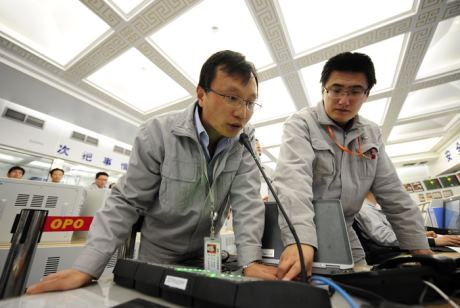China has formally launched its first indigenous nuclear power reactor design, with some French ancestry but born of two major internal contests, writes Ian Hore-Lacy.
The Hualong One reactor design has passed its design certification by the National Nuclear Safety Administration (NNSA) and has now been launched with some fanfare by the National Energy Administration (NEA) which brought it about by high-level edict.
The story starts in 2004 when the State Council approved building two power plants with Generation-III technology from overseas to step decisively ahead of the imported technology and first iteration of indigenous reactor designs then in operation. Despite strong representation that China should go it alone technologically, an international open bidding process was undertaken. This asserted China's readiness to be part of the global nuclear industry, while some in China remained somewhat ambivalent about that.
 |
| Control room workers announce first criticality at Hongyanhe 2 in October 2013. The CGN-led plant will have four CPR-1000s while the fifth and sixth units will be either of the Hualong One or AP1000 design (Image: CGN) |
The new State Nuclear Power Technology Corporation (SNPTC), directly under the State Council, was in charge of technology selection for new plants from overseas. Some 200 experts spent over a year evaluating reactor designs and in September 2006 most votes were for the Westinghouse AP1000. This then became the main design for China's nuclear future, endorsed at the highest level. Four reactors are now well advanced in construction, and SNPTC has presided over evolving the design to a larger CAP1400 with full Chinese intellectual property rights.
But meanwhile China National Nuclear Corporation (CNNC) had been working with others since the early 1990s to develop an indigenous 1000 MWe design based on the smaller units at Qinshan, which had started up from 1994. The decision to go for the AP1000, early in 2007, saw CNNC's main engineering support redirected to the AP1000, leaving CNNC stranded in its ambition to create its own brand of reactor with Chinese intellectual property rights. But after a few years' hiatus, CNNC resumed development of its design and in October 2011 announced that its independently-developed ACP1000 was entering the engineering design stage.
CNNC's ambitions were being matched by China Guangdong Nuclear Power Corporation (now China General Nuclear – CGN) which was busy developing the French M-310 design it had built at Daya Bay and Ling Ao. This was very successful and became the CPR-1000, with a nearly-complete domestic supply chain, but it was still basically a Generation-II reactor, with Areva retaining some intellectual property rights which prevented export. The CPR-1000 was being widely and quickly deployed for domestic use, with 57 likely to be built, as of the end of 2010. But following the Fukushima accident, there will be no further approvals, since Generation-III is the new criterion. Six CPR-1000s are now operating and 16 are under construction. Since it was the only domestic design of its size, it is being built by CNNC as well as CGN, which was developing it towards Generation-III status with full Chinese intellectual property rights.
So in 2011 State Council and its National Energy Administration (NEA) were faced with the two major nuclear utilities, CGN and CNNC, sponsoring rival 1000 MWe class designs, the Guangdong CPR-1000 well proven, the ACP1000 still only on paper. At the same time, the companies were geographically diverse, with CNNC based in Beijing, and CGN based in Shenzhen, Guangdong province, where the local government held a 45% stake.
This desired 'rationalisation' of reactor designs was supported by greater commonality in ownership of the two companies as ordered in September 2012. Beijing asserted its authority and took over 82% of CGN, reducing provincial ownership to 10%. Accordingly, Beijing ordered the two companies to merge their designs into one, with Generation-III credentials, while allowing for minor differences. This was a challenge, since the cores are very different: the ACP1000 design has 177 fuel assemblies 3.66 metres long, the ACPR1000 has 157 assemblies 4.3 metres long. In the event the ACP1000 core design prevailed, though it was less mature. This is the new flagship - Hualong One - although CGN and CNNC still maintain their own supply chains, supporting 85% local content, and some features developed by CGN for its Advanced CPR-1000 will be incorporated into its versions of Hualong One.
The NEA, NNSA and National Development and Reform Commission have now confirmed that the Hualong One meets all technology requirements for a Generation-III reactor with full Chinese intellectual property rights and good export potential. They urged early deployment of demonstration units in China to prepare the way for exports as "an important brand" for Chinese nuclear technology. The first units will be built at Fangchenggang - units 3 and 4 (by CGN) followed by Fuqing 5 and 6 (by CNNC). Although it is still officially listed as being ACP1000, Pakistan's Karachi Coastal Power station are likely to be the first export Hualong units.
Ian Hore-Lacy
Comments? Please send them to editor@world-nuclear-news.org
Ian Hore-Lacy is a Senior Research Analyst with the World Nuclear Association. One of the WNA's longest serving staffers, Ian is the author of the organisation's Information Library.




_53514_33880.jpg)

_91467.jpg)
_47120.jpg)



